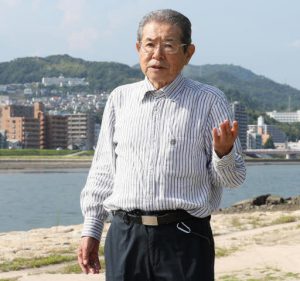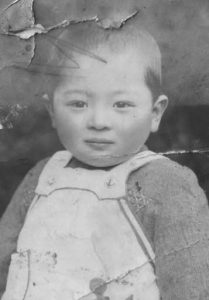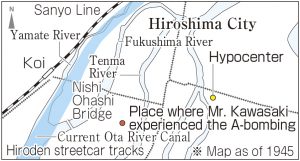Survivors’ Stories: Hiroaki Kawasaki, 81, Hiroshima: Continuing to appeal for a world without nuclear weapons
Aug. 5, 2019
by Kyoko Niiyama, Staff Writer
Hiroaki Kawasaki, 81, experienced the atomic bombing at the age of seven, and his family fled through the city of Hiroshima. He still remembers the dreadful sights he saw: the scores of bodies strewn everywhere and the suffering of those that were injured. He shares his memories with younger generations as an “A-bomb Survivor Testimony” of the City of Hiroshima.
Back in 1945, Mr. Kawasaki lived with his paternal grandparents, his parents, his 4-year-old sister, and his 1-year-old brother in Higashikanon-machi (now part of Nishi Ward), about 1.3 kilometers from the hypocenter. He evacuated to the northern part of Hiroshima Prefecture with his grandmother around May out of concern that Hiroshima’s city center could become the target of air raids. However, he missed his family, and he and his grandmother returned home before August 6, the day of the A-bomb attack.
That morning, Mr. Kawasaki’s father, a teacher at the national school affiliated with Hiroshima Normal School (now Shinonome Elementary School affiliated with Hiroshima University, located in Minami Ward), left for work, and the rest of the family were playing with Mr. Kawasaki’s brother in the living room. Mr. Kawasaki wanted to play outside and he was putting on his shoes at the entrance. At that moment, he found himself enveloped by an intense flash of light, and then the house quickly collapsed. The six family members were pinned down by pillars and the ceiling, which had fallen.
Mr. Kawasaki’s mother and brother had been sprayed by shards of glass, but everyone managed to crawl out from the wreckage. “Let’s flee to the west!” They headed toward a relative’s house, with frantic steps, though the wreckage of the city stood in their way.
When they arrived at the Nishi Ohashi Bridge (now in Nishi Ward), over the Fukushima River of that time, many people had already sought refuge there. The Kawasaki family joined a long procession of other victims and continued walking. Some people were bleeding profusely from their heads, and others had skin dangling off their burnt arms. A woman who was walking right in front of them suddenly sat down from exhaustion.
Overwhelmed by the horrific sights, Mr. Kawasaki was constantly looking all around so his grandmother frequently cautioned him to continue walking and only look at the toes of his shoes. When they came near the present-day Ota River Canal, people were lying on the ground as if sandwiched in the thickets of the reeds. He is unable to forget the sight of a young brother and sister as they anxiously clung to their dead mother.
The family continued heading north and arrived at their relative’s house in the Kabe district (now part of Asakita Ward) late that night. Mr. Kawasaki’s father, who experienced the atomic bombing near the Tsurumi Bridge (now in Naka Ward), was burned badly on his back and arms, but a few days later, one of his relatives came and carried him to the house and he managed to survive.
Mr. Kawasaki worked for a major construction firm for many years, moving to various locations in Japan. During this time, he did not squarely face his A-bomb experience. However, he suffered a heart attack while in his 50s soon after he returned to Hiroshima. Moreover, he lost his mother due to a heart attack and his brother at the age of 54 due to lung cancer, one after the other. He believes that their health problems were caused by the atomic bombing. Thus, he wanted to know the current conditions of A-bomb survivors who suffered from the effects of their radiation exposure.
In 2016, Mr. Kawasaki became an “A-bomb Legacy Successor” for the City of Hiroshima to hand down the experience of another A-bomb survivor. Mr. Kawasaki helps to hand down the experience of Mr. Mitsuo Kodama, which conveys, based on Mr. Kodama’s experience, that the atomic bomb has even done damage to human chromosomes. The horror of such an experience is beyond Mr. Kawasaki’s imagination.
The more Mr. Kawasaki saw A-bomb survivors making efforts to hand down their experiences to the next generation, the more he felt encouraged to do the same. He wondered, though, if it was appropriate for him to talk about his experience because he experienced the bombing when he was small and his memories of that time are vague. Despite this concern, he began speaking about his experience as an A-bomb survivor in 2017 and, so far, has trained 15 “A-bomb Legacy Successors.”
This summer, a student at Motomachi High School made a painting of Mr. Kawasaki’s experience of the atomic bombing to help convey these memories to the next generation. He believes that if we continues to highlight the horrors of the atomic bombing in various ways, a world without nuclear weapons can surely be created.
Teenagers’ Impressions
Listening to direct account left a huge impact
Mr. Kawasaki said, “I want you to talk about my A-bomb experience to your family and friends.” I felt his strong hope that the tragedy wrought by the atomic bombing would be understood by as many people as possible. Because the opportunities to listen to A-bomb survivors’ accounts first-hand are decreasing, I want to stay committed to my work as a junior writer, feeling the importance of his words. (Miki Meguro, 16)
I want to learn about these events and tell others
Mr. Kawasaki fled through the city with the six members of his family. I think the fact that their A-bomb experiences are part of his family history is a really sad and bitter thing. I want to learn about the war and the devastation caused by the atomic bomb and tell people from other prefectures and non-Japanese people, too, so that nuclear weapons, which had transformed the appearance of people and the city of Hiroshima, are never used again. (Yukari Furohashi, 15)
(Originally published on August 5, 2019)
Hiroaki Kawasaki, 81, experienced the atomic bombing at the age of seven, and his family fled through the city of Hiroshima. He still remembers the dreadful sights he saw: the scores of bodies strewn everywhere and the suffering of those that were injured. He shares his memories with younger generations as an “A-bomb Survivor Testimony” of the City of Hiroshima.
Back in 1945, Mr. Kawasaki lived with his paternal grandparents, his parents, his 4-year-old sister, and his 1-year-old brother in Higashikanon-machi (now part of Nishi Ward), about 1.3 kilometers from the hypocenter. He evacuated to the northern part of Hiroshima Prefecture with his grandmother around May out of concern that Hiroshima’s city center could become the target of air raids. However, he missed his family, and he and his grandmother returned home before August 6, the day of the A-bomb attack.
That morning, Mr. Kawasaki’s father, a teacher at the national school affiliated with Hiroshima Normal School (now Shinonome Elementary School affiliated with Hiroshima University, located in Minami Ward), left for work, and the rest of the family were playing with Mr. Kawasaki’s brother in the living room. Mr. Kawasaki wanted to play outside and he was putting on his shoes at the entrance. At that moment, he found himself enveloped by an intense flash of light, and then the house quickly collapsed. The six family members were pinned down by pillars and the ceiling, which had fallen.
Mr. Kawasaki’s mother and brother had been sprayed by shards of glass, but everyone managed to crawl out from the wreckage. “Let’s flee to the west!” They headed toward a relative’s house, with frantic steps, though the wreckage of the city stood in their way.
When they arrived at the Nishi Ohashi Bridge (now in Nishi Ward), over the Fukushima River of that time, many people had already sought refuge there. The Kawasaki family joined a long procession of other victims and continued walking. Some people were bleeding profusely from their heads, and others had skin dangling off their burnt arms. A woman who was walking right in front of them suddenly sat down from exhaustion.
Overwhelmed by the horrific sights, Mr. Kawasaki was constantly looking all around so his grandmother frequently cautioned him to continue walking and only look at the toes of his shoes. When they came near the present-day Ota River Canal, people were lying on the ground as if sandwiched in the thickets of the reeds. He is unable to forget the sight of a young brother and sister as they anxiously clung to their dead mother.
The family continued heading north and arrived at their relative’s house in the Kabe district (now part of Asakita Ward) late that night. Mr. Kawasaki’s father, who experienced the atomic bombing near the Tsurumi Bridge (now in Naka Ward), was burned badly on his back and arms, but a few days later, one of his relatives came and carried him to the house and he managed to survive.
Mr. Kawasaki worked for a major construction firm for many years, moving to various locations in Japan. During this time, he did not squarely face his A-bomb experience. However, he suffered a heart attack while in his 50s soon after he returned to Hiroshima. Moreover, he lost his mother due to a heart attack and his brother at the age of 54 due to lung cancer, one after the other. He believes that their health problems were caused by the atomic bombing. Thus, he wanted to know the current conditions of A-bomb survivors who suffered from the effects of their radiation exposure.
In 2016, Mr. Kawasaki became an “A-bomb Legacy Successor” for the City of Hiroshima to hand down the experience of another A-bomb survivor. Mr. Kawasaki helps to hand down the experience of Mr. Mitsuo Kodama, which conveys, based on Mr. Kodama’s experience, that the atomic bomb has even done damage to human chromosomes. The horror of such an experience is beyond Mr. Kawasaki’s imagination.
The more Mr. Kawasaki saw A-bomb survivors making efforts to hand down their experiences to the next generation, the more he felt encouraged to do the same. He wondered, though, if it was appropriate for him to talk about his experience because he experienced the bombing when he was small and his memories of that time are vague. Despite this concern, he began speaking about his experience as an A-bomb survivor in 2017 and, so far, has trained 15 “A-bomb Legacy Successors.”
This summer, a student at Motomachi High School made a painting of Mr. Kawasaki’s experience of the atomic bombing to help convey these memories to the next generation. He believes that if we continues to highlight the horrors of the atomic bombing in various ways, a world without nuclear weapons can surely be created.
Teenagers’ Impressions
Listening to direct account left a huge impact
Mr. Kawasaki said, “I want you to talk about my A-bomb experience to your family and friends.” I felt his strong hope that the tragedy wrought by the atomic bombing would be understood by as many people as possible. Because the opportunities to listen to A-bomb survivors’ accounts first-hand are decreasing, I want to stay committed to my work as a junior writer, feeling the importance of his words. (Miki Meguro, 16)
I want to learn about these events and tell others
Mr. Kawasaki fled through the city with the six members of his family. I think the fact that their A-bomb experiences are part of his family history is a really sad and bitter thing. I want to learn about the war and the devastation caused by the atomic bomb and tell people from other prefectures and non-Japanese people, too, so that nuclear weapons, which had transformed the appearance of people and the city of Hiroshima, are never used again. (Yukari Furohashi, 15)
(Originally published on August 5, 2019)










